
| FARM CONTEXT | |
| Date of visit | 7 April 2021 |
| Area | Herbertsdale, CAPE |
| Soils | Clay-heavy soils |
| Rainfall | 650mm per year (winter rain) |
| Altitude | 364m |
| Distance from the coast | 50kms as crow flies |
| Temperature range | 1C (no frost) – 38/40, sometimes 46C Hottest time is in Feb. Get cold wind off Outiniqua Mountains |
| Humidity | High – blossom blight challenges |
| Winds | Not a factor |
| Varieties | Majority Beaumont, now grafting in Nelmak 2 and an unregistered variety |
| Hectares under mac | 9 hectares total farm, 5 hectares under mac |
| Other crops | None |
I drove and I drove and i drove, up, up, up into the mountains until I was absolutely sure that I was on the wrong road because there was just no way that macs could be producing at this altitude! Hell, It felt like I was so high up that the only thing surviving was probably baboons, snakes and cabbage trees … maybe proteas … but I couldn’t see anything agricultural. To be honest, I couldn’t see anything at all as I was now in the clouds. I began to wonder whether I’d find aeroplanes …

Feeling completely lost, not trusting Google Maps that the farm could possibly be this remote – above the clouds and any other signs of agriculture …
There was no way I could risk a U-turn on this narrow, misty road so I kept going. Eventually, humanity appeared in the form of a lone stroller ambling down the road and then, not too far after that, I found a gate … Praise Heaven, it was the right gate! What a ride! Once I knew I was not going to be lost forever on this mountain and the relief flooded through my body, I was SO excited to meet this Jaff. I have always been drawn to people who pathwalk; those who follow their own dreams no matter how “outlandish” they seem to others.
Meet the Mountain Jaffs! They’re earthy, determined and passionate – everything I expected to find in this far-flung location. Whenever we encounter someone on the periphery, we always find lots of interesting challenges and solutions so settle down for a fascinating insight into just where macs will grow … if you have the perseverance to find out.

The view, once the mist burnt off.
Mr & Mrs Jaff work side by side, as they have most of their lives. They are originally from Cape Town where they spent 17 years running a very successful electronics business. As happens with many small businesses that find great success, it burnt them out – Mr Jaff woke up one day unable to continue. He needed to escape. A small ad in the Farmers Weekly led them into the mountains … they decided to follow through with the “escape plan” and have now been here for 24 years.
The property had a few cottages on it and these were the intended income source. Agriculturally, there was very little going on; just bush, pine and blue gum forests. To keep busy, Jaff tried growing vegetables but found that they’re just too far away from the markets for this crop to be viable (no surprise there!). As the children grew and ‘varsity fees threatened the family budget, he started to consider what else he could do to bridge the gap. The single, large, prolific macadamia tree in the garden started to draw his attention to possibilities along those lines. There was another mac tree, just off their farm, and it also produced well. He consulted a local “mac professor” who encouraged them to plant. So, 17 years ago, they sold the pine and planted macs.
LAND PREP
Most of the orchards are well-ridged. This was done to cope with water run-off and allow tractor access on the steeper slopes. This property has seen 13 floods in the 24 years Jaff has been here. I wonder whether I am the only one who struggled to understand how floods happen on mountains … apparently they do, and the torrential downpours literally take everything with them. Jaff explains how they have had to knock bricks out of buildings so that the water can run through them rather than completely destroy them. The worst they’ve had was 380mm in 2 days. This much water, on this gradient, results in raging torrents.
Before ridging, lime was worked into the initial orchards but Jaff surmised that, with all the pine needles in the next phase of orchard establishments, the soil would be neutral enough, so, when he planted these a few years later, he didn’t lime. Not verifying his theory with soil tests turned out to be a beeeg mistake. Four years ago he had to choose between ripping these orchards out completely or implementing a very expensive micro-liming programme. He opted for the latter and these macs are now starting to turn the viability corner.
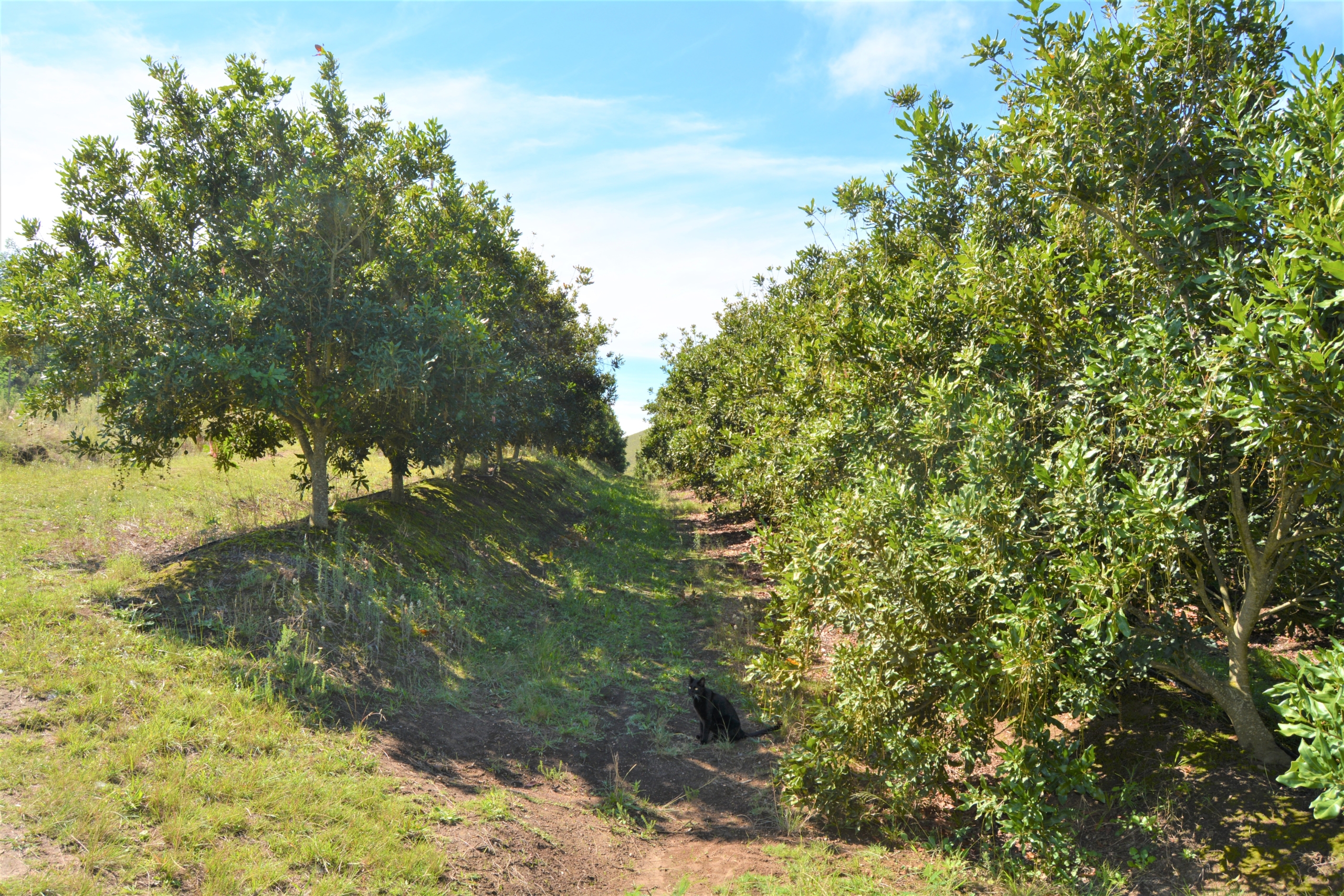
Ridges (and the farm cat) clearly visible.
PLANTING – SPACING & CULTIVAR CHOICE
Jaff was advised to plant pure Beaumont blocks at 3m x 5m spacing. He regrets following any of that advice and recommends that others never go denser than 8m x 4m, maybe even 9m x 4m if you have the space. Single cultivar blocks were also a bad idea; he recommends planting multiple cultivars that will enable cross-pollination and allow you to assess which cultivars are best suited to your climate, soil and farming style.
Jaff sourced his initial Beaumonts from a farmer who had bought but decided not to plant. They originated from a registered nursery and were good stock.
Mr & Mrs Jaff dug every single hole and planted every single tree themselves. At night, they’d sit and make up the drip lines, rolling them out the next day. Being so remote means that labour is not easy to find and going to fetch the hands required, from the village 13 kms away, soon proved to be a waste of time as the “hands” were often drunk or not there at all. Hard work never killed anyone so they committed to the task themselves and got it done.
THINNING OUT AND GRAFTING IN NEW CULTIVARS
After much painful contemplation Jaff came to the point where he had to thin the orchards out.

A fire, 4 years ago, meant that there was an insurance claim and Elsje Joubert, a well-known and respected consultant from the Levubu region, came to the farm to conduct the assessment. She explained that she wouldn’t have cut these trees out at all, opting instead for more aggressive management. This advice inspired Jaff and he decided to introduce new cultivars into the orchards by grafting onto the regrowth from the stumps. Another phase of learning … what varieties should he introduce?
His mind went immediately to the big tree in the garden. Elsje couldn’t conclusively identify it but it was closest to a Kikea (508). It seemed to do well in this climate and so Jaff went ahead with 500 grafts. About 70% took but only 3 trees have ever produced nuts!! Why, no one knows.
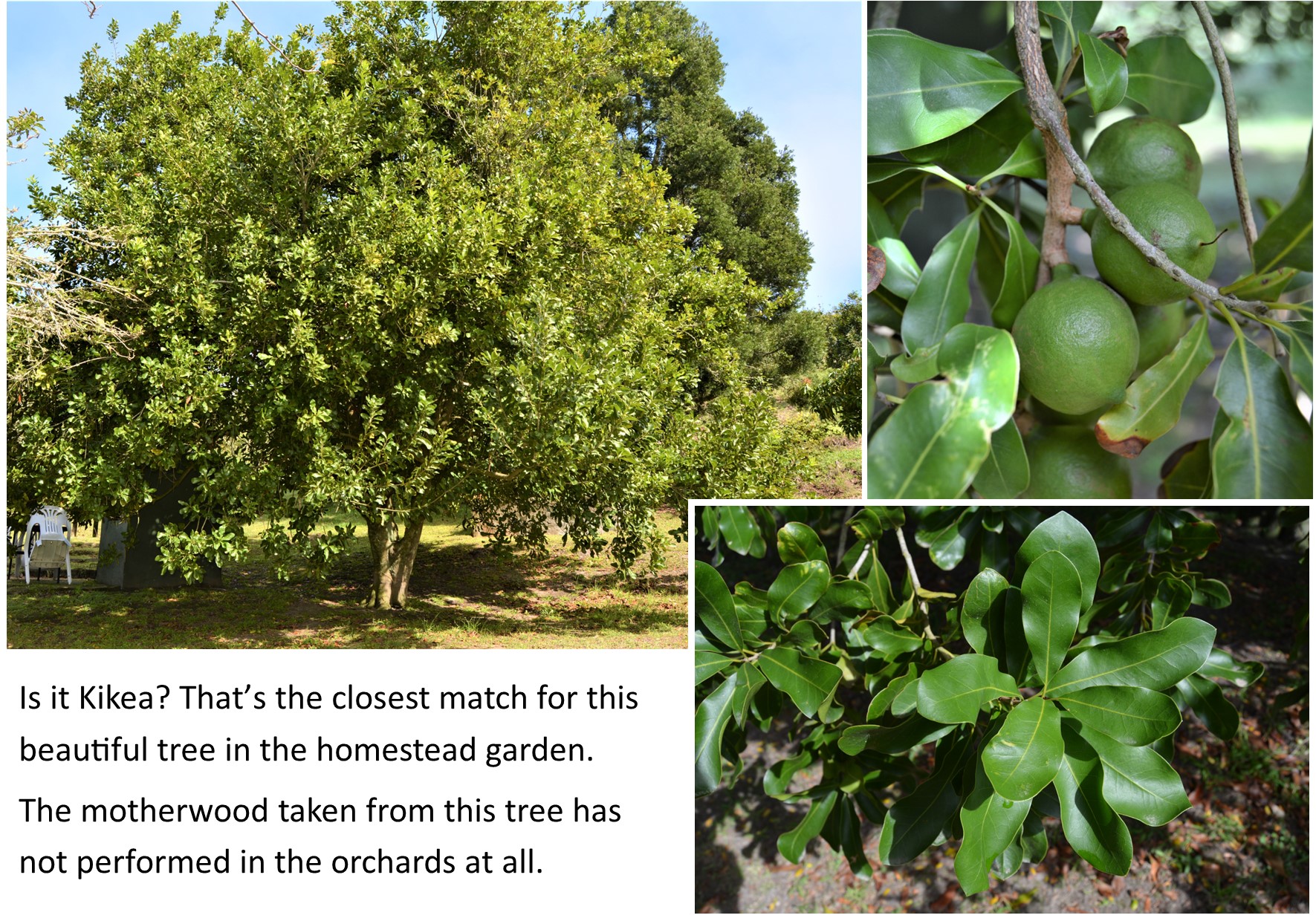
Jaff also used motherwood from the tree just outside his property – he has no idea what cultivar this is and so it is known only as “the neighbour’s tree”. The grafts from this tree produce well and it is used throughout the orchards.
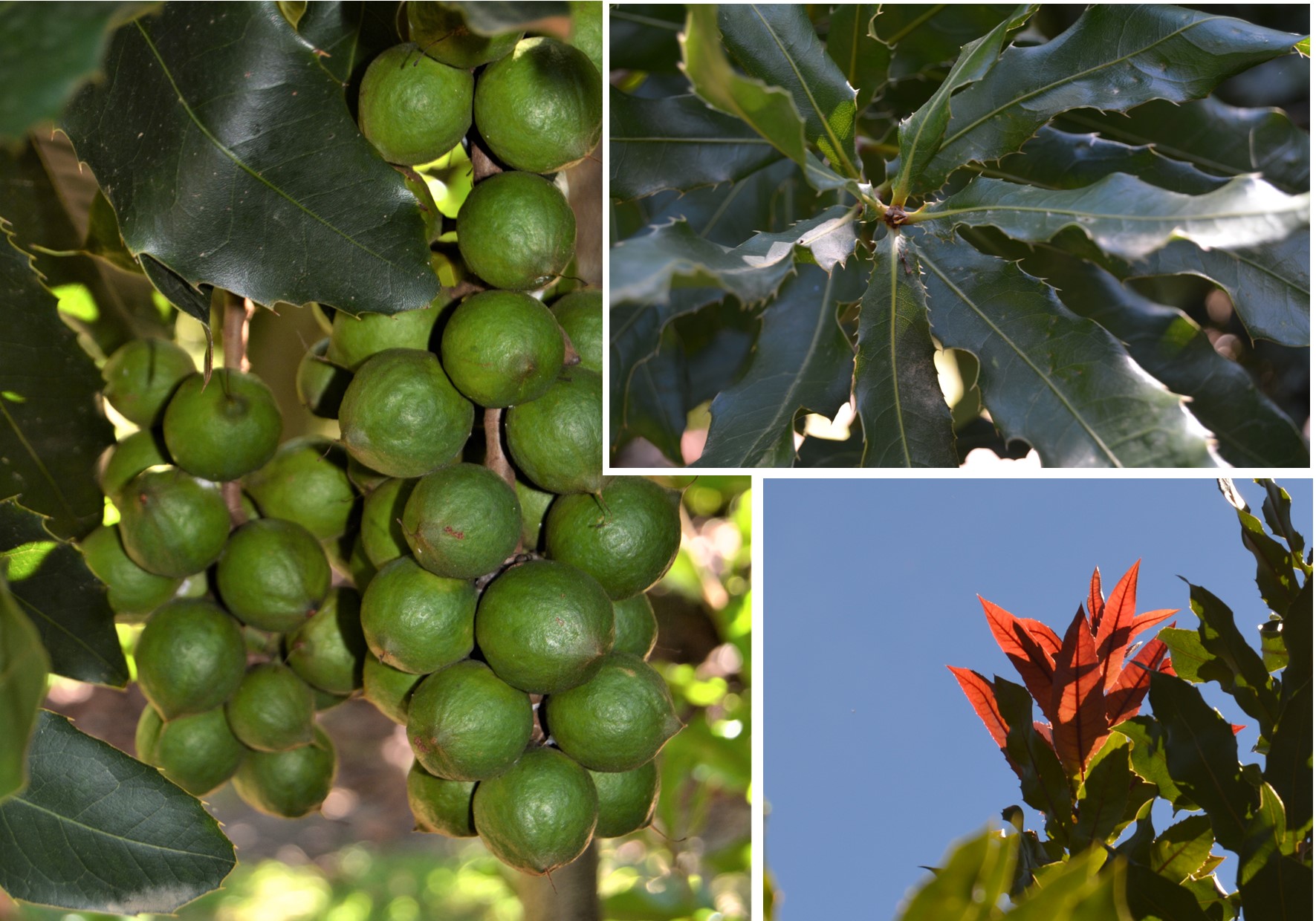
At first glance it looks a lot like Beaumont but Jaff highlights the differences for me: the new flush is a much more vibrant red, the mature leaves are darker, and there is only one flowering as opposed to Beaumont’s 2 or 3. The husks are also not as rough as a Beaumont.
Besides “might-be-Kikea” and “neighbour’s tree” Jaff also uses Nelmak 2 to add cross-pollination material into the orchards. Although Nelmak is producing very well, much of the fruit hangs low making it prime bush pig fodder.

Nelmak 2 nuts on a 2-year-old graft.
Jaff favours whip grafting. He prepares the budwood by dipping the top 3/4 in wax. These waxed pieces are taken into the orchard where they are trimmed and matched to a fresh shoot of similar size. Because the top is already waxed, only the join needs grafting tape to water-proof it.
There doesn’t seem to be a standard “take time” for grafting – Jaff has discovered that sometimes a graft you think has failed will suddenly shoot, even up to 4 months later. Up until learning this, Jaff had been removing “failures” prematurely and warns anyone in this same situation to have patience.
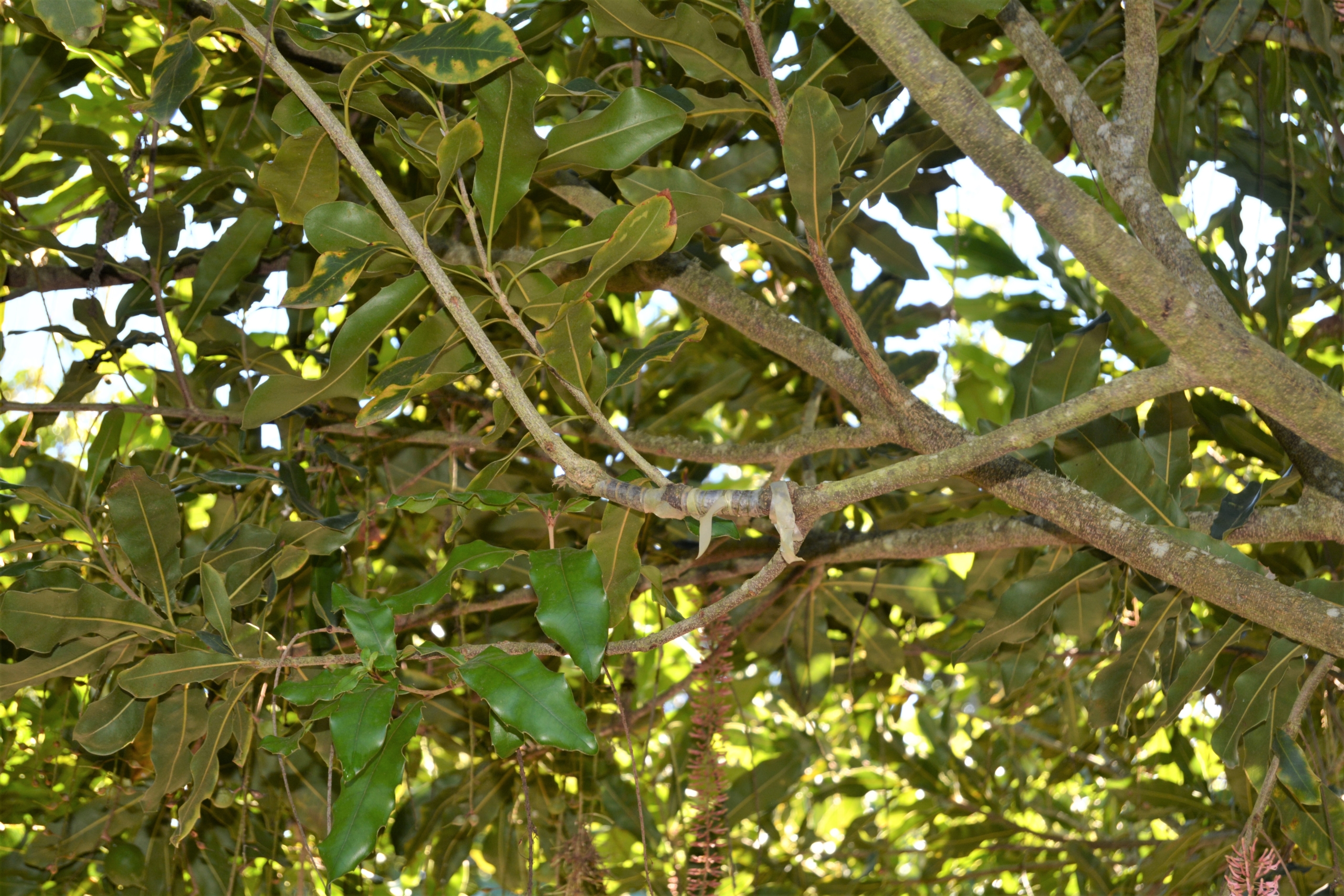
Tape still evident on a successful graft.
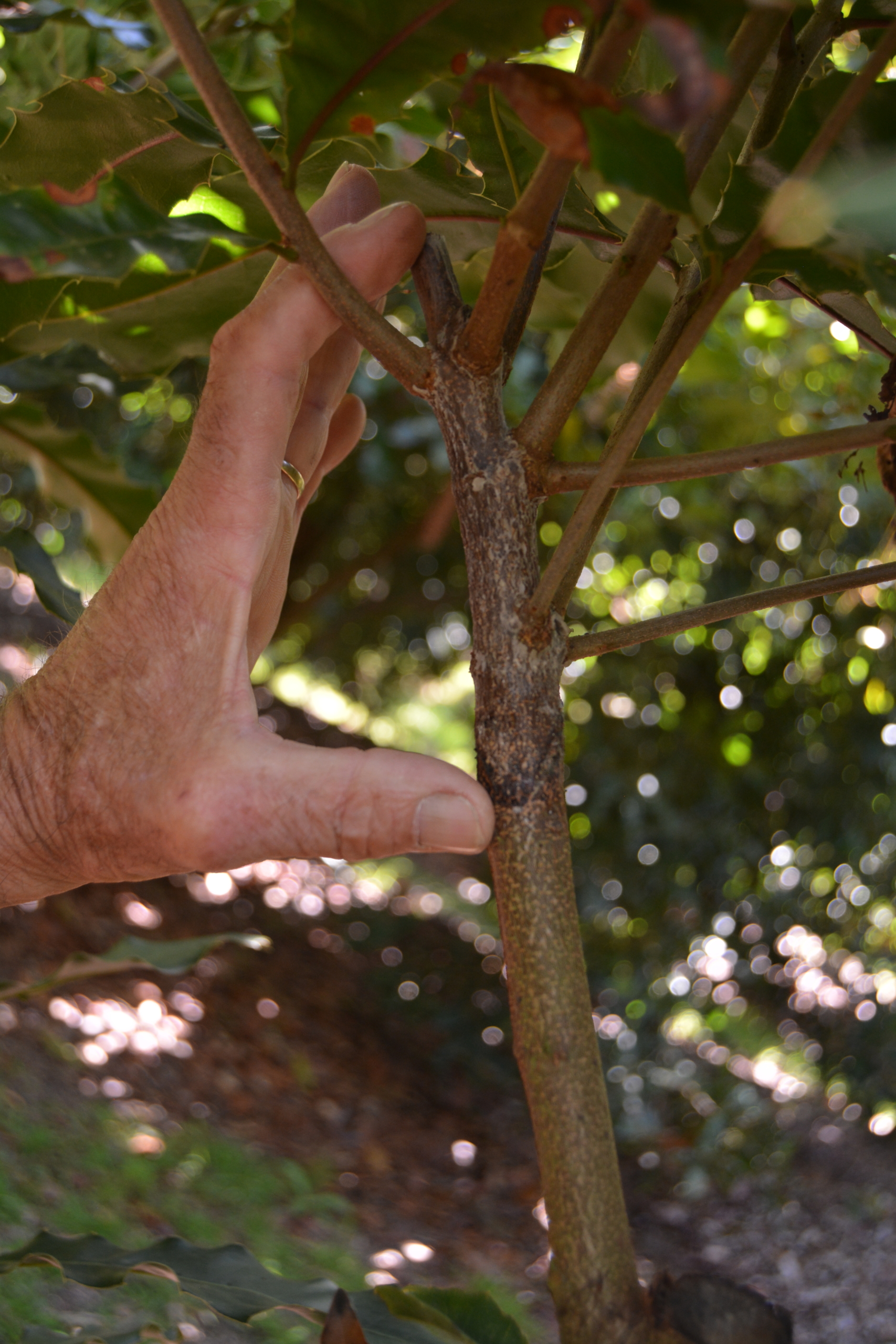
A successful graft done the beginning of 2020.
TRAGEDY & OTHER DISEASES
It went well for so long. The trees grew and flourished. Although the macadamias had not stepped up in time to pay any varsity fees, they were (at last) starting to look like they might be worth the blood, sweat and tears they had cost.
When the trees were about 11 years old, Mr & Mrs Jaff went away for a very short and well-deserved break. When they came back, Jaff walked the orchards as all good farmers do when they’ve been away for more than half an hour. What he found was devastating! Every single flower was gone; shrivelled and black. Distraught, Jaff eventually picked up the courage to return to the house and share the distressing news with his wife – there would be no crop this year. They had no idea what had caused this desolation or how they were going to recover.
The 2012 harvest was 250kgs. For four years this continued. The first flowering would be decimated by this unidentified blackness and then the second flowering would result in a few nuts. They spent all their savings trying to survive these years. They consulted everyone they could afford, calling in specialist after specialist. Jaff researched independently and thought that Blossom Blight was the most likely culprit but the specialists said no, this wasn’t Blossom Blight, not in this area. Eventually samples were sent to Stellenbosch University for analysis and it was confirmed; Blossom Blight. Jaff could have cried (again) that he had suspected this but allowed the “specialists’ knowledge” to over-ride his own with the result that they had all but bankrupted themselves.
Although I love wide open, unpopulated spaces with no neighbours, sometimes the support of nearby farmers or surrounding community, who can advise and guide, can be invaluable to a fledgling farmer.
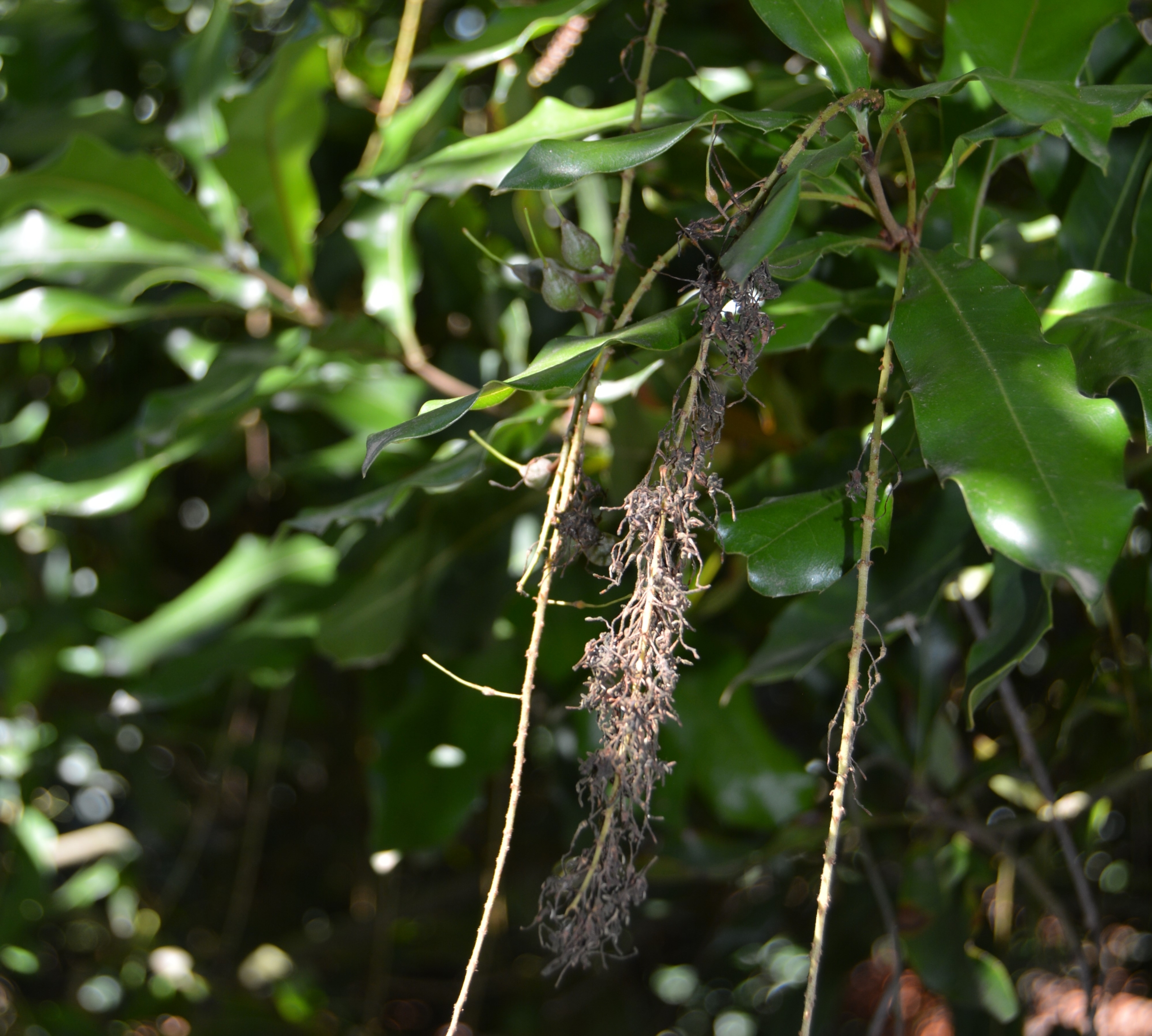
I found signs of this killer as we walked through the orchards.
Although it hasn’t been devastating since he found the solution in 2016, he does have be proactive and spray preventatively every August/September.

Thankfully Jaff has never had to contend with phytophthora – they once thought they had it but it turned out to be sunburn. The ‘scar’ can be seen on the trunk of this tree.
WATER
Besides the relatively generous rainfall this farm enjoys, it is also served by the Dwars river and 2 springs. Even through the recent devastating Cape droughts, they always had a small supply and all the trees survived.
Having no one upstream means that this water is pristinely clean. A particular fish, called the rooivlertjie, is often used by biologists to evaluate water quality; if they survive in the water, it indicates excellent quality … well, in these rivers, rooivlertjies live wild and thrive.
Drip irrigation is used on all trees and while it has served them well, Jaff is not sure he’d chose it over micros now that the trees are bigger. He feels the water dispersion (or lack thereof) is too localised even though he has recently added additional holes to the pipeline and it now delivers 16l per hour.

Irrigation dripper – fertilisers are applied through the irrigation system.

The river-fed dam.
NUTRITION
After the devastation that Blight inflicted on yield and, consequently, finances, the trees did not get any nutrition for a few years. As soon as he was able, Jaff sourced a company who could help him recover. They advised a 3-year restoration programme. He explains that the cost has been exorbitant but he has gritted his teeth and resigned to the experts in this regard, openly admitting that he faithfully follows the prescribed programme which will close out the 3 years at the end of this season. He has trust in the company he’s chosen to support him through the myriad of products on offer – they have done the soil and leaf sampling and formulated the plans. The anticipated yield this season is around 14 to 15 tonnes – dry in shell (off 5 hectares). Overall, this is a marked improvement although Jaff thinks he may have overfed the bottom orchards resulting in excessive vegetative growth. Nothing a good prune and fertiliser adjustment for next year can’t fix.
The nutrition experts have also conducted many (foliar) trials on his farm. Although many farmers resist trials on their orchards, Jaff’s trees were in such bad shape that he felt he had more to learn than loose. He hasn’t been wrong but wasn’t comfortable sharing his unqualified or verified observations before the trials are finalised – I guess we’ll know soon enough.

Well-fed (and rather overgrown) 17-year-old orchard.
PESTS
The challenges Jaff faces are a clear reminder that he is farming in a whole different ecosystem to the typical macadamia farmer. Bush pigs, baboons, locusts, porcupines, snakes … the list seems endless, with the usual insects being of lesser concern.
Let’s inspect them one at a time: Jaff’s animated frustration with bushpigs is a clear indicator that these creatures are on his most-hated list right now and when we came across all the evidence, I fully understood his desperation.

Pigs had pulled off and devoured many kilos of nuts the night before – the evidence was everywhere.
Local baboons are quickly acquiring a taste for these nutritious snacks. They sit on the surrounding hillsides, waiting for, and communicating between themselves, opportunities to invade. Jaff has taken to parking an old bakkie on one side of the orchard – he has to move it every few hours as the baboons are quick learners and will assume human absence if the bakkie stays still too long. One of the staff, who live on the farm, also carries a pellet gun (without ammunition) as the clever primates are intelligent enough to appreciate the implied danger.

The baboons run reconnaissance from this hill that has a nice clear view of most of the orchards.

The decoy – an old bakkie.
Porcupines do the normal thing … chew through piping. While this is very frustrating, Jaff would happily trade them for less bushpigs right now.
Jaff also casually mentioned boomslangs as an occupational hazard on this farm. My heart almost stopped when he said, “yes – they are all over the show – we don’t even bother about them anymore.” I almost got back to my car and locked the doors before he explained that these snakes have been unjustly villainised. They are incredibly shy and very slow to bite. I verified this info with a quick Google consult and decided to man up and get back to work. Jaff then tested my new-found bravery by recounting a story of when they found they’d been sharing the lounge with an almost 2-metre specimen for ‘who knows how long’ until the cat tipped them off to the intruder. (We were sitting in said lounge at the time!)
I swiftly moved the conversation on to less terrifying rogues of the insect-variety … Stink bugs. Jaff says these really aren’t an issue. He has needed to spray once or twice but only in response to finding a few of the critters on his ‘tell-tale’ trees. Yes – Jaff is lucky enough to have a few trees that always attract the stinkbugs first so, instead of scouting in the traditional sense, he just strolls over to the mpimpis (Africanism for ‘snitch’) to inspect. He has 5 of these trees throughout the farm; one is an oak tree in the garden (pictured below), one is the original might-be-Kikea tree in the garden and the other 3 are her “offspring” in the orchards (the only 3 that produce nuts).
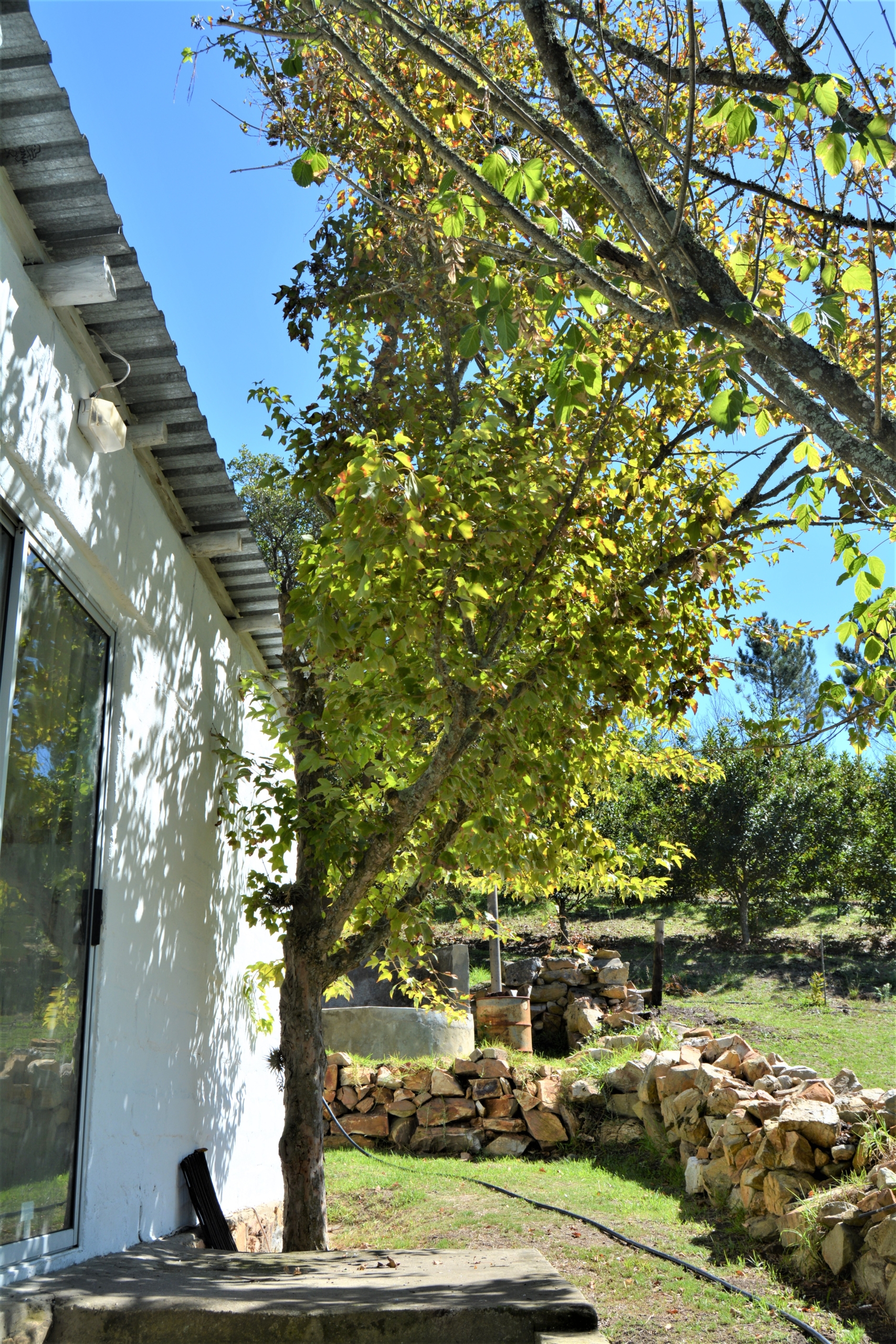
The stink-bug mpimpi tree. Jaff discovered that this tree was a stinkbug favourite when it was completely engulfed in coconut bugs one day. Panicked, Jaff rushed into the orchards but there was no sign of any further issues. Since then, he has used this tree as a scout site and it has proved to be a valuable early warning system, every time.
Jaff suspects that their lack of stink bugs are due to their remote location and the vast tracts of natural bush surrounding the farm.
Mealy bugs and aphids are also present but Jaff accepts those as standard and sprays when he sees them. One year he had an infestation of ants so extreme he had use poison. Not only were the ants burrowing under buildings and the driveway but they had also built nests around the base of the macadamia trees – you couldn’t touch a nut with being covered in ants. He chose to use a very expensive focus poison (that the ants take back into their nests) which he applied on the tree trunks. It took a (highly tense) week to work but it worked!

Where accessible, the tractor is used to spray, otherwise the quad-bike fills in on the tight or steeper orchards.
Jaff is cautious about using poisons and not only for the sake of the environment – he darn near killed himself in the early days … Mrs Jaff found him passed out in the passage and rushed him to hospital. After extensive testing it was discovered that he had cypermitherin poisoning. Since then he not only wears the prescribed protective gear but also limits spraying to the absolute essential.
Having recently discovered a new pest in the orchards is causing sincere concern – hopefully the red spider’s days are numbered as Jaff is just waiting to hear what he should use to curb the spread of this insect that is damaging leaves, especially the new flush.
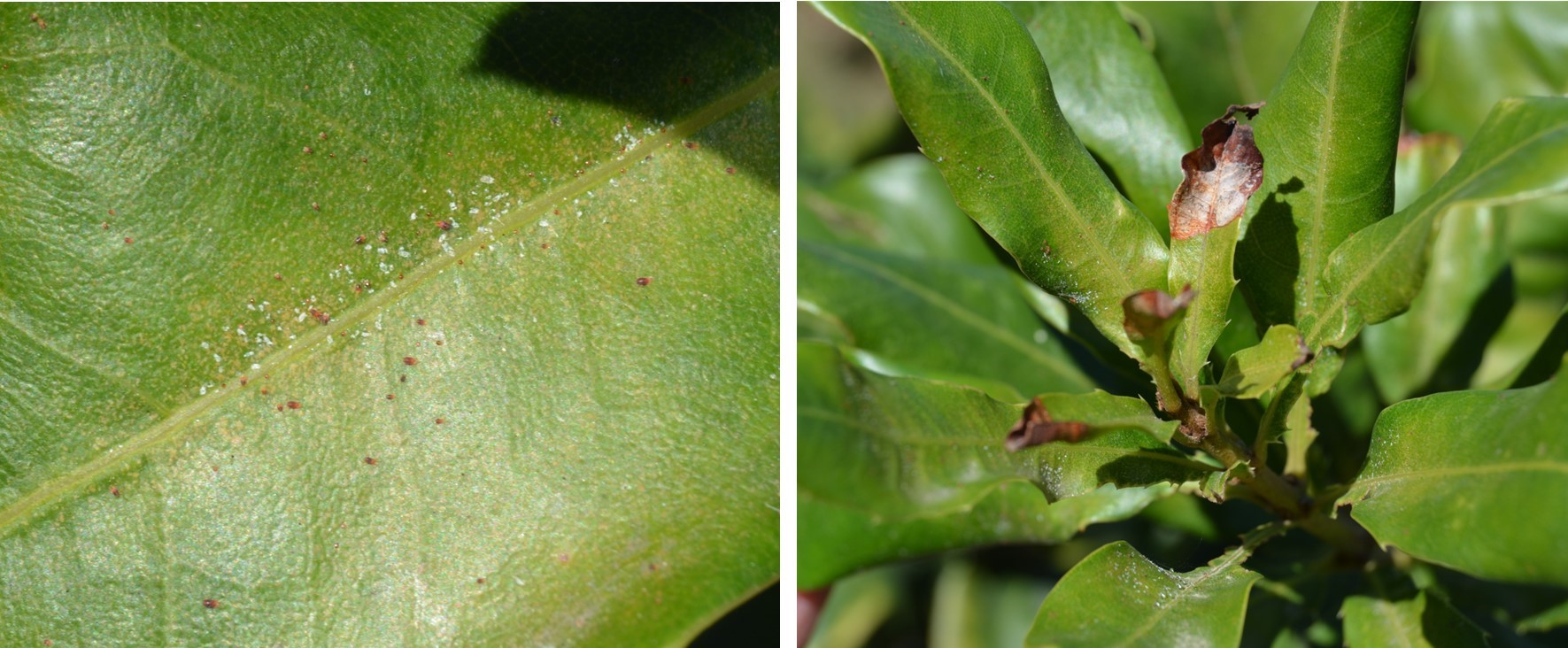
The red spiders are minute but the damage they do to new flush is considerable.

If anyone knows what might be causing these leaves to curl, please let me know. Jaff suspects the red spiders but isn’t sure …
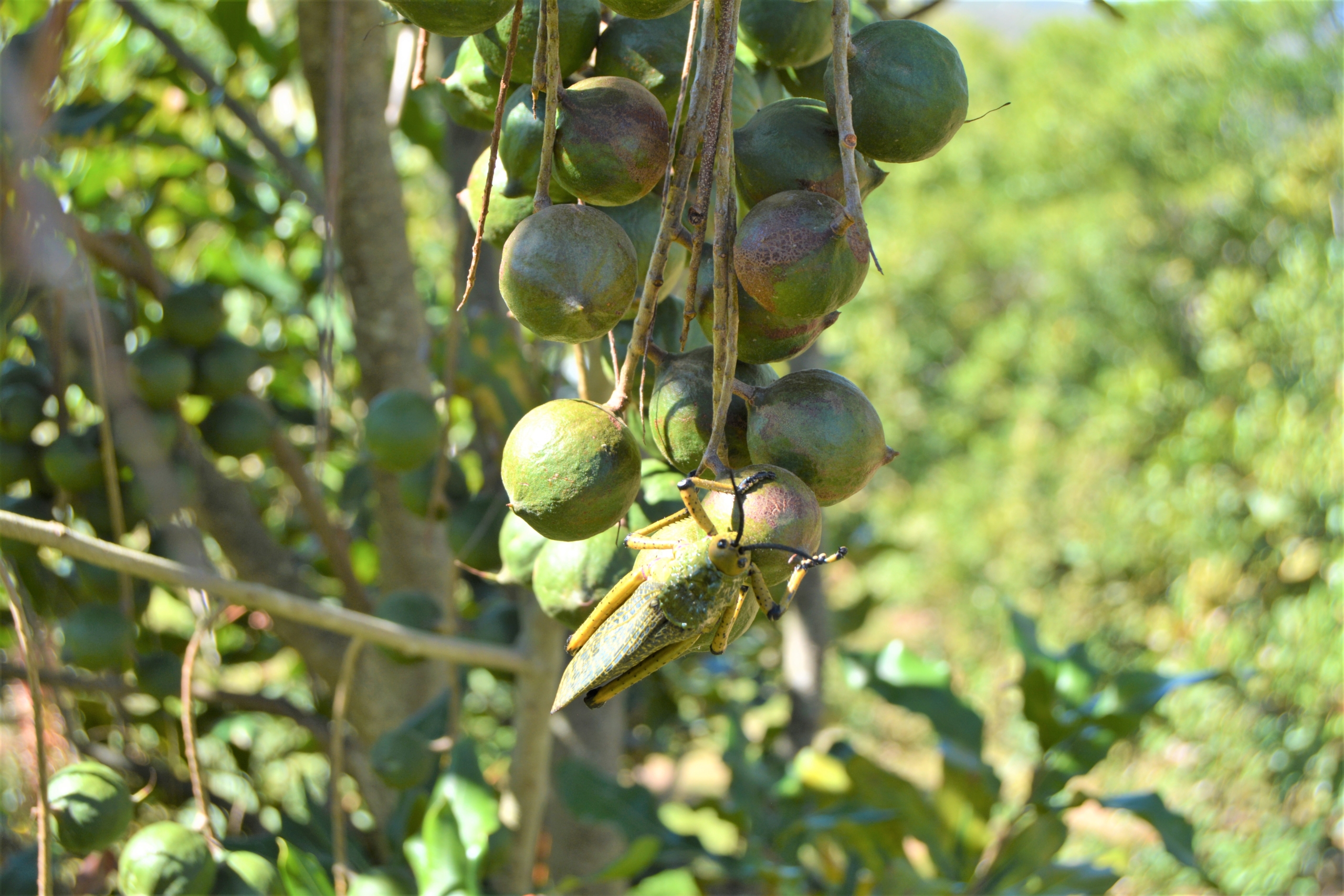 Even locusts have plagued this farm in the past.
Even locusts have plagued this farm in the past.
PRUNING
Like so many mac farmers, Jaff finds pruning painful. Besides the trauma of cutting back growth he has actively encouraged, he also struggles with timing; Beaumonts are prone to multiple flowerings and therefore multiple crops – there just ever seems to be an ideal time to prune.
Reverting to using his head rather than his heart he sanely adds that, as painful as it is, it is also a vitally important activity. Jaff prefers the rose-shape prune to the Christmas tree-shape, probably because of the limited space in his orchards.

By using this shape and keeping the trees under 4m high he feels sunlight penetration is maximised.
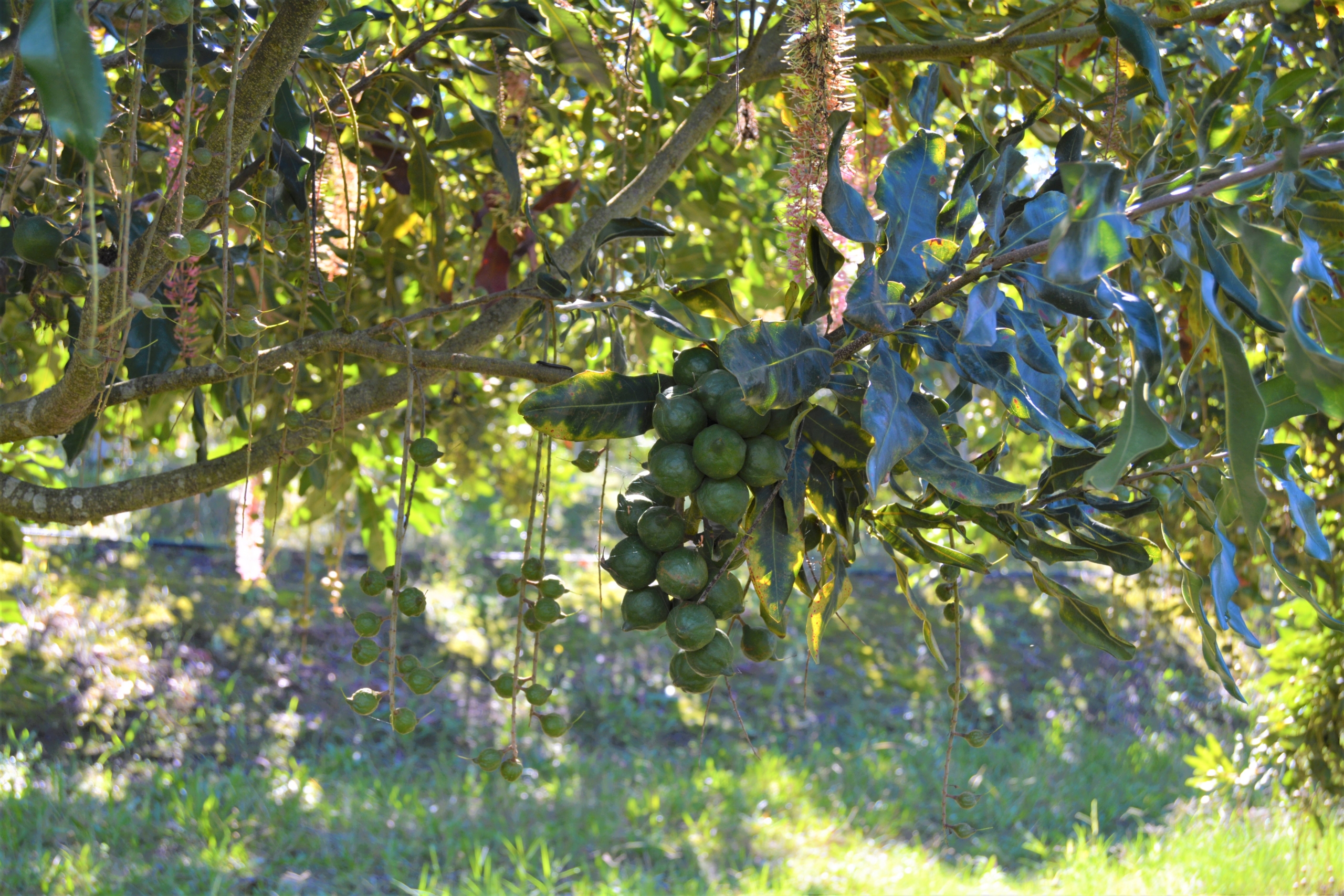
Perfect illustration of the Beaumont farmer’s dilemma – flowers, small and large nuts all on one tree.
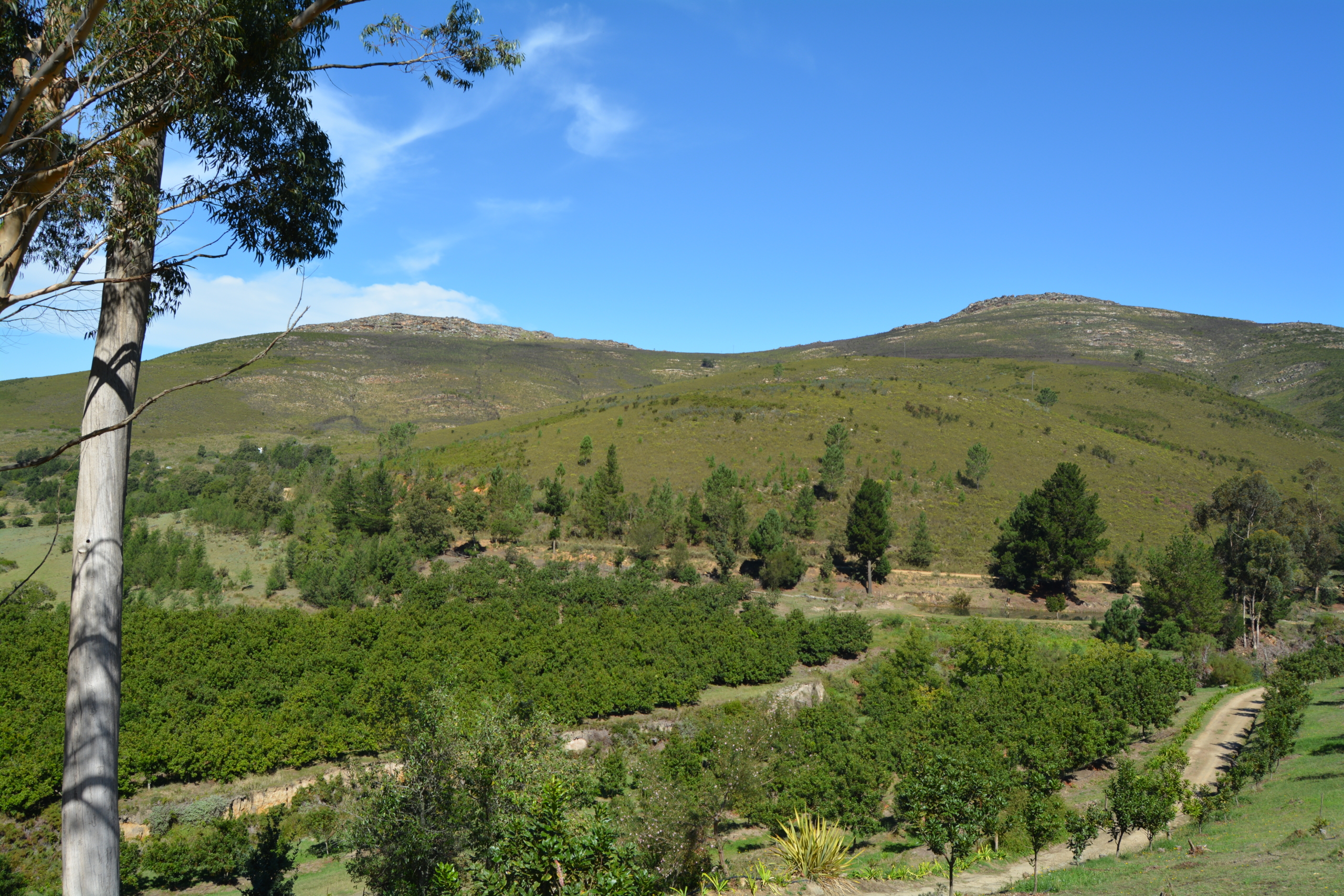
The rows in this main orchard are barely discernible. Jaff is considering pruning every second row right down this year, and the alternate rows the following year.
This (overgrown) orchard, pictured above, delivered the farm’s best yield last year, after a good prune, but this year, it is the worst. Jaff believes it is because it is, once again, so overgrown.
MULCHING
Jaff generates a mulch from husk, sheep kraal manure and prunings. He puts this around the trees as required. The sheep manure comes from his own small marino herd that are kept for home consumption. When I asked why he doesn’t leave them in the orchards, Jaff explained that his orchards do not have enough grass for them and they eat all the mac flowers within reach.

HARVEST
Activity on this farm is planned around two harvests. This is because the Beaumonts flower at least twice and Jaff maximises his returns by getting all he can off the trees. Usually the main haul is gleaned in the first harvest but, this year, he thinks that the second will be bigger.
Because of this double harvest, Jaff does not use ethapon, fearing the impact it will have on the younger, immature nuts. They also can’t risk the nuts falling on the floor, making it even easier for those pesky pigs to rob them. So, they use hooked sticks and manually pull all the nuts off the trees.
Once the nuts have been dehusked and the smalls removed, they lie on the closed shed floor to dry overnight and reduce the stickiness. The following day the nuts go into the driers where they enjoy ambient air pushed through by fans from 9am to 4pm every day for about 2 weeks.
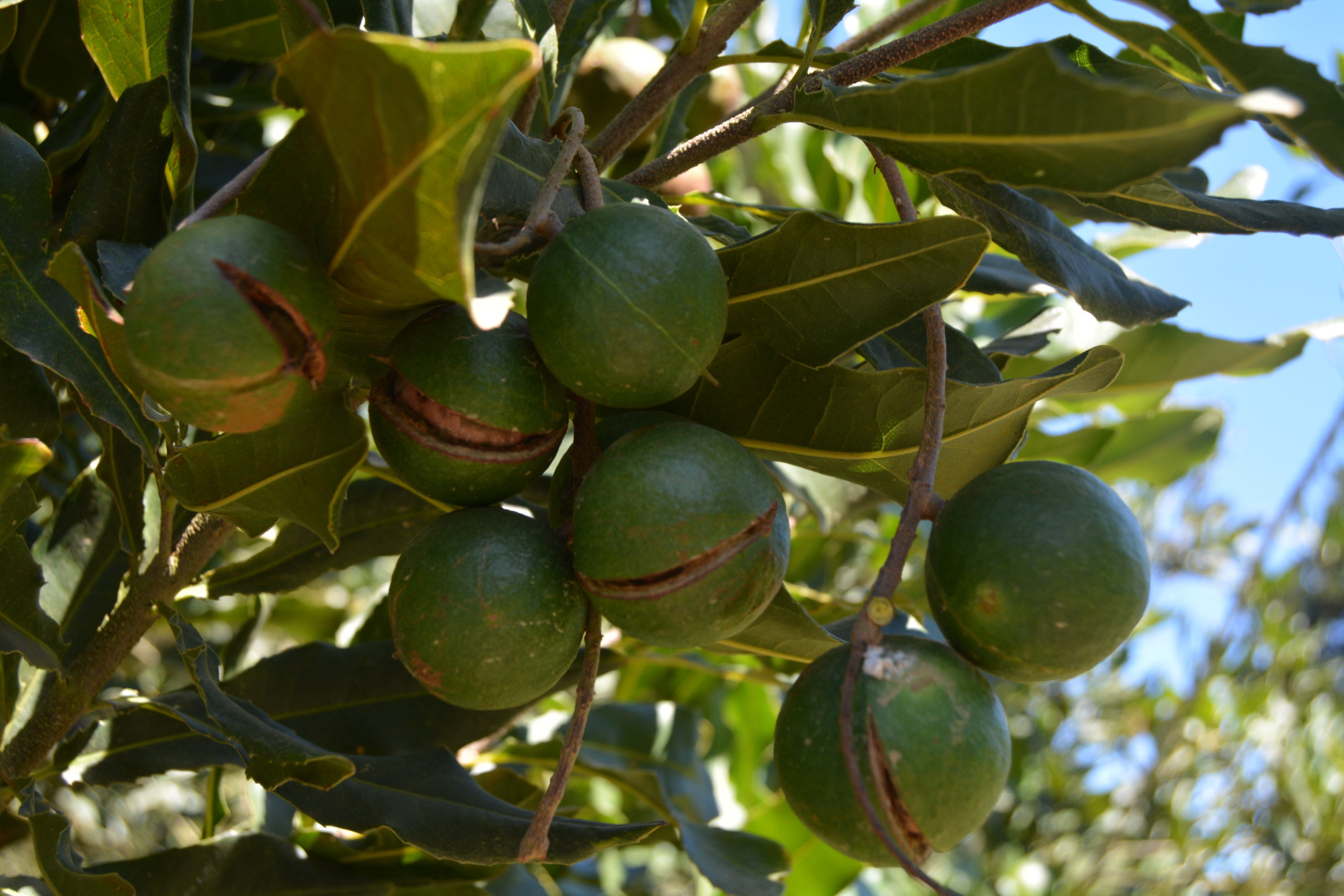
If anyone knows why these husks split, please drop me an email. Jaff hasn’t figured it out yet but says the nuts seem to be unaffected.
Generally they take 6 to 8 weeks to harvest although the 2020 year (covid year) took 3 months because there were only 3 of them on the farm (inc Mr & Mrs Jaff) to do the work.
PROCESSING
The ‘taste test’ is used to assess moisture content; if it tastes like macadamia, it is dry. If it tastes like coconut, it’s too wet. Although this seems to lack science, the processor has never charged them drying fees so it must work!
From there the processor collects the nuts (now that’s impressive!) but Jaff keeps a small amount – last year it was 1,5 tonnes – which he then processes further and markets under their own label, through their pub on the farm or their facebook page ( Dwarsrivier Country Getaway | Facebook ) They roast, salt, coat with chocolate or make macadamia butter. Yes, I was a good customer and indulged heartily, using the excuse that I may get lost on the way home and require sustenance.
Jaff explains that the work required to process the nuts further is really not worth the meagre income the products generate but they have built up a loyal base of consumers through the pub and the little ‘shop’ is a valuable feature for all visitors.

These ostrich egg incubators make the perfect drying and roasting units for the nut products Jaff produces on the farm.
SUPPLEMENTARY INCOME – COTTAGES & PUB
I imagine the flow of adventurous souls through the cottages help to keep Jaff both social and sane. The accommodation is basic but beautiful and attracts mostly hikers or bikers. The farm is on the “Rim of Africa” route and draws these groups in for a night on the trail. Besides the 4 cottages, there are also camping facilities down by the river.

Camping area alongside the river.
ADVICE
When I ask Jaff whether he has any final advice he says “Don’t farm!”
Really?
“No, I would choose it again! I was cooped up in a workshop for far too long. I love the outdoors and the challenges. Some have almost broken me but I wouldn’t change much.”
Mrs Jaff is not quite as enthusiastic … she was happy in the city and wouldn’t mind being closer to civilisation. She came to this farm when she was only 29 and, as wonderful as it has been, she can’t help but feel that the time to move further down the mountain is not far off.
It’s also starting to get a bit busier up here now, with more and more people, especially from Johannesburg, pursuing the same seclusion the Jaffs once sought.
PARTING THOUGHTS
Reflecting back on this visit I am reminded of the raw reality of the pioneer. These Jaffs tried something new and it was anything but easy. But, because of all their hard work and perseverance, others will have a greater chance of success. I sincerely hope that the investment, strength and pure grit, shown by these Jaffs, is richly rewarded in all the seasons they have left on this mountain.
Thank you for sharing your world with me.








